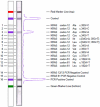Comparison of neuroendocrine differentiation and KRAS/NRAS/BRAF/PIK3CA/TP53 mutation status in primary and metastatic colorectal cancer
- PMID: 25337237
- PMCID: PMC4203208
Comparison of neuroendocrine differentiation and KRAS/NRAS/BRAF/PIK3CA/TP53 mutation status in primary and metastatic colorectal cancer
Abstract
Neuroendocrine differentiation of tumor tissue has been recognized as an important prerequisite for new targeted therapies. To evaluate the suitability of colorectal cancer (CRC) tissue for these treatment approaches and to find a possible link to pretherapeutic conditions of other targeted strategies, we compared neuroendocrine differentiation and KRAS/NRAS/BRAF/PIK3CA/TP53 mutational status in primary and metastatic CRC. Immunohistochemical expression analysis of neuroendocrine markers chromogranin A and synaptophysin was performed on archival CRC tissue, comprising 116 primary tumors, 258 lymph node metastases and 72 distant metastases from 115 patients. All CRC samples but 30 distant metastases were subjected to mutation analysis of KRAS, NRAS, BRAF, PIK3CA, and TP53. Neuroendocrine marker expression was found significantly less frequently in lymph node metastases compared to primary tumors and distant metastases (20%, 31%, 28%, respectively, P = 0.044). KRAS mutation rates increased significantly from primary tumors to lymph node metastases and distant metastases within the neuroendocrine negative CRC group (44%, 53%, 64%, respectively, P = 0.042). Neuroendocrine differentiation was significantly less concordant than KRAS/NRAS/BRAF/PIK3CA/TP53 mutational status in primary tumor/lymph node metastases pairs (65% versus 88%-99%; P < 0.0001) and primary tumor/distant metastases pairs (64% versus 83%-100%; P = 0.027 and P < 0.0001, respectively). According to these data, therapeutic targeting of neuroendocrine tumor cells can be considered only for a subset of CRC patients and biopsies from the metastatic site should be used to guide therapy. A possible importance of lacking neuroendocrine differentiation for progression of KRAS mutant CRC should be further investigated.
Keywords: KRAS mutations; Neuroendocrine differentiation; colorectal cancer.
Figures



Similar articles
-
Mitochondrial DNA alteration in primary and metastatic colorectal cancer: Different frequency and association with selected clinicopathological and molecular markers.Tumour Biol. 2017 Mar;39(3):1010428317692246. doi: 10.1177/1010428317692246. Tumour Biol. 2017. PMID: 28345467
-
Effectors of epidermal growth factor receptor pathway: the genetic profiling ofKRAS, BRAF, PIK3CA, NRAS mutations in colorectal cancer characteristics and personalized medicine.PLoS One. 2013 Dec 10;8(12):e81628. doi: 10.1371/journal.pone.0081628. eCollection 2013. PLoS One. 2013. PMID: 24339949 Free PMC article.
-
Analysis of KRAS, NRAS, PIK3CA, and BRAF mutational profile in poorly differentiated clusters of KRAS-mutated colon cancer.Hum Pathol. 2017 Apr;62:91-98. doi: 10.1016/j.humpath.2016.12.011. Epub 2016 Dec 24. Hum Pathol. 2017. PMID: 28025078
-
The predictive value of KRAS, NRAS, BRAF, PIK3CA and PTEN for anti-EGFR treatment in metastatic colorectal cancer: A systematic review and meta-analysis.Acta Oncol. 2014 Jul;53(7):852-64. doi: 10.3109/0284186X.2014.895036. Epub 2014 Mar 25. Acta Oncol. 2014. PMID: 24666267
-
Recommendations from the EGAPP Working Group: can testing of tumor tissue for mutations in EGFR pathway downstream effector genes in patients with metastatic colorectal cancer improve health outcomes by guiding decisions regarding anti-EGFR therapy?Genet Med. 2013 Jul;15(7):517-27. doi: 10.1038/gim.2012.184. Epub 2013 Feb 21. Genet Med. 2013. PMID: 23429431
Cited by
-
Progression inference for somatic mutations in cancer.Heliyon. 2017 Apr 11;3(4):e00277. doi: 10.1016/j.heliyon.2017.e00277. eCollection 2017 Apr. Heliyon. 2017. PMID: 28492066 Free PMC article.
-
An Overview of Altered Pathways Associated with Sensitivity to Platinum-Based Chemotherapy in Neuroendocrine Tumors: Strengths and Prospects.Int J Mol Sci. 2024 Aug 6;25(16):8568. doi: 10.3390/ijms25168568. Int J Mol Sci. 2024. PMID: 39201255 Free PMC article. Review.
-
The Increasing Relevance of Tumour Histology in Determining Oncological Outcomes in Colorectal Cancer.Curr Colorectal Cancer Rep. 2015;11(5):259-266. doi: 10.1007/s11888-015-0280-7. Curr Colorectal Cancer Rep. 2015. PMID: 26321889 Free PMC article. Review.
-
Prognostic Value of BRAF and KRAS Mutation in Relation to Colorectal Cancer Survival in Iranian Patients: Correlated to Microsatellite Instability.J Gastrointest Cancer. 2020 Mar;51(1):53-62. doi: 10.1007/s12029-019-00201-4. J Gastrointest Cancer. 2020. PMID: 30635874
-
Neuroendocrine differentiation: The mysterious fellow of colorectal cancer.World J Gastroenterol. 2015 Nov 7;21(41):11740-7. doi: 10.3748/wjg.v21.i41.11740. World J Gastroenterol. 2015. PMID: 26556999 Free PMC article. Review.
References
-
- McCubrey JA, Steelman LS, Abrams SL, Lee JT, Chang F, Bertrand FE, Navolanic PM, Terrian DM, Franklin RA, D’Assoro AB, Salisbury JL, Mazzarino MC, Stivala F, Libra M. Roles of the RAF/MEK/ERK and PI3K/PTEN/AKT pathways in malignant transformation and drug resistance. Adv Enzyme Regul. 2006;46:249–279. - PubMed
-
- Scaltriti M, Baselga J. The epidermal growth factor receptor pathway: a model for targeted therapy. Clin Cancer Res. 2006;12:5268–5272. - PubMed
-
- Allegra CJ, Jessup JM, Somerfield MR, Hamilton SR, Hammond EH, Hayes DF, McAllister PK, Morton RF, Schilsky RL. American Society of Clinical Oncology provisional clinical opinion: Testing for KRAS gene mutations in patients with metastatatic colorectal carcinoma to predict response to anti-epidermal growth factor receptor monoclonal antibody therapy. J. Clin. Oncol. 2009;27:2091–2096. - PubMed
-
- Oden-Gangloff A, Di Fiore F, Bibeau F, Lamy A, Bougeard G, Charbonnier F, Blanchard F, Tougeron D, Ychou M, Boissiere F, Le Pessot F, Sabourin JC, Tuech JJ, Michel P, Frebourg T. TP53 mutations predict disease control in metastatic colorectal cancer treated with cetuximab-based chemotherapy. Br J Cancer. 2009;100:1330–1335. - PMC - PubMed
Publication types
MeSH terms
Substances
LinkOut - more resources
Full Text Sources
Medical
Research Materials
Miscellaneous
